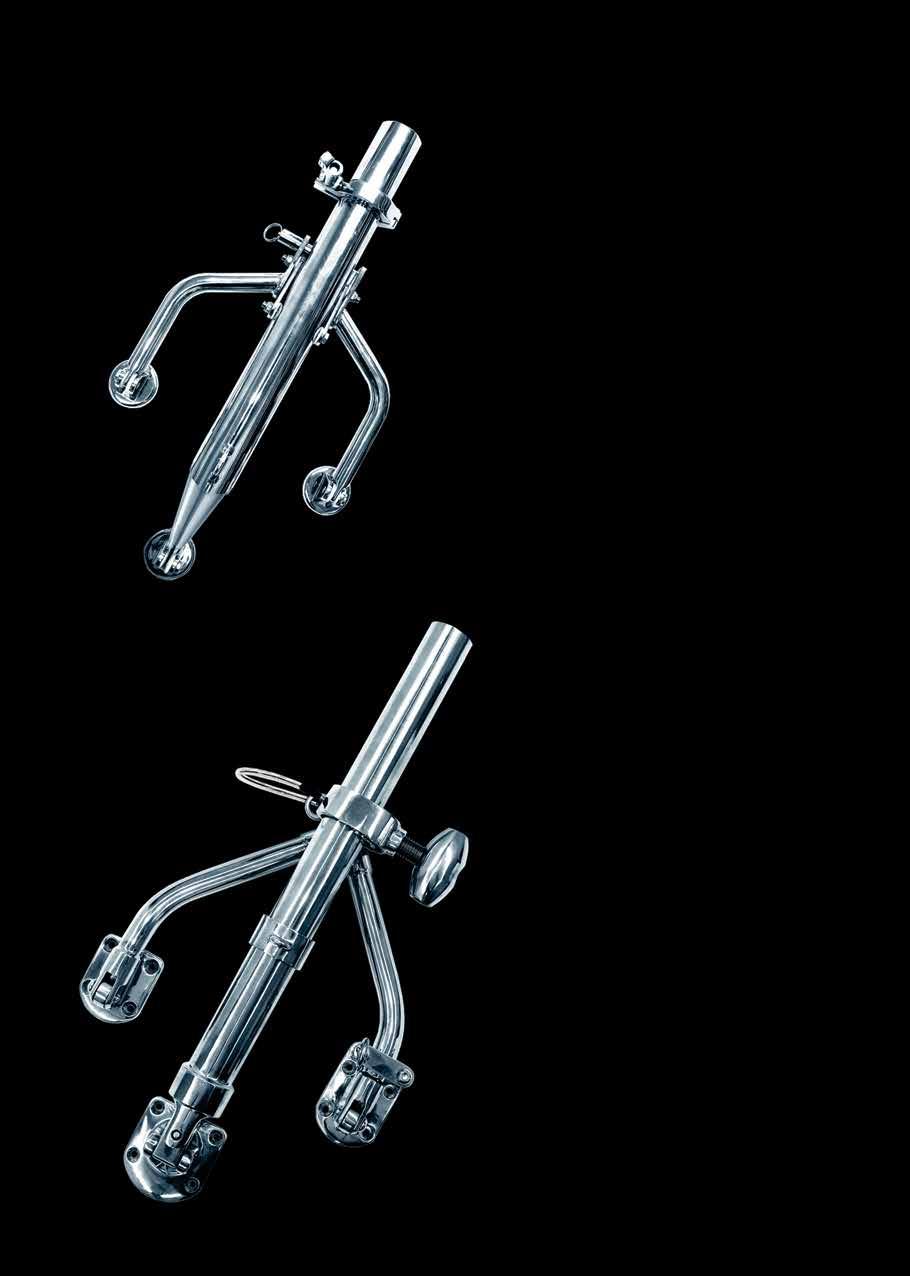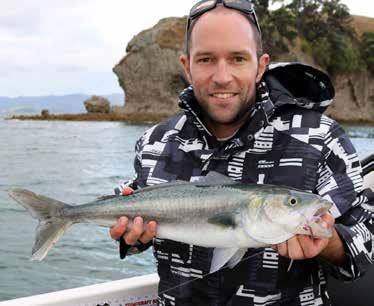
15 minute read
Illustrated Guide to Equipment Regulations
from 2021 NZSFC Yearbook
DOUBLE LINES AND LEADERS
Double lines are measured from the start of the knot, braid, roll or splice making the double line to the farthermost end of the knot, splice, snap, swivel or other device used for securing the trace, leader lure or hook to the double line. A double line must consist of the actual line used to catch the fish. For saltwater species, the double line shall be limited to 15 feet (4.57 meters) for all line classes up to and including 20 lb (10 kg); and shall be limited to 30 feet (9.14 meters) for line classes over 20 lb (10 kg). For freshwater species, the double line on all classes of tackle shall not exceed 6 feet (1.82 meters).
Advertisement
The leader shall be limited to 15 feet (4.57 meters) for saltwater species in line classes up to and including 20 lb (10 kg), and 30 feet (9.14 meters) for all line classes over 20 lb (10 kg). For freshwater species, the leader on all classes of tackle shall be limited to 6 feet (1.82 meters).
The length of the leader is the overall length including any lure, hook arrangements or other device.
The combined length of the double line and leader shall not exceed 20 ft (6.1 meters) in line classes up to and including 20 lb (10 kg) and 40 feet (12.19 meters) in line classes over 20 lb (10 kg) for saltwater species. The combined length of the double line and leader shall not exceed 10 feet (3.04 meters) for freshwater species.
ILLUSTRATED GUIDE TO HOOK REGULATIONS NATURAL BAITS AND ARTIFICIAL

LEGAL if eyes of hooks no more than 18 inches (45.72 cm) apart in baits and no more than 12 inches (30.45 cm) apart in lures. ILLEGAL if eyes further apart than these distances.

NOT LEGAL as the second or trailing hook extends more than the hook’s length beyond skirt. See also two hook rigs.

NOT LEGAL in bait or lures as eyes of hooks are less than a hook’s length (the length of the largest hook) apart.

LEGAL as eyes of hooks are no less than a hook’s length apart and no more than 18 inches (45.72 cm) in baits and 12 inches (30.45 cm) in lures.

LEGAL in baits and lures. The point of one hook is passed through the eye of the other hook. LEGAL as eyes of hooks are no less than a hook’s length apart and no more than 12 inches (30.45 cm) apart, and the trailing hook does not extend more than a hook’s length beyond the skirt.


LEGAL as hook is contained within the skirt.

NOT LEGAL as the single hook extends more than its length beyond the skirt.

NOT LEGAL as back hook is not firmly imbedded in or securely attached to bait and is a dangling or swinging hook.

LEGAL as both hooks are firmly imbedded or securely attached to bait. Would not be legal if eyes of hooks were more than 18 inches (45.72 cm) apart.
GAFFS
Flying Gaffs - LEGAL on boats if effective rope length does not exceed 30 feet (9.15 meters).


ANGLERS, CREWS, BOAT OWNERS & CHARTER BOAT CAPTAIN’S RESPONSIBILITIES WHEN THEY COME INTO THE WEIGH STATION
1. Every angler, crew, boat owner and charter boat captain must make themselves totally familiar with the fishing rules and regulations set down by IGFA ,
NZSFC and individual clubs and their tournaments. 2. The weighperson is in charge of the weighstation.
Anglers, crew, boat owners and charter boat captains are required to work in with the weighperson with the handling and the presentation for the weighing of fish. 3. The angler must complete the weigh sheet other than the weight before presenting the fish to the weighperson. 4. If a fish has any new wounds other than the clean gaffing wound or wounds such as may be inflicted by a propeller or another predator this will disqualify the fish. If this fish is weighed in a mutilated condition it will not qualify for any IGFA, NZSFC,
Club or tournament trophies or prizes. 5. Parties are requested to co-operate with the weighperson to check any relevant equipment related to this catch. 6. The angler or their representative must be on hand to make sure the scales are zeroed before weighing the fish. Also the angler or representative must be present to verify the weight of the fish when the weighperson has the final weight. 7. Parties are requested not to get into any consultation over any disagreement that may occur at the weighstation with the weighperson.
Any disagreements should be taken to the appropriate person in charge of fishing regulations within the club for them to adjudicate over.
When the weighperson is the weighmaster and judge they will then adjudicate on the IGFA and
NZSFC fishing rules and regulations, along with any club and tournament rules that may apply.
WEIGHPERSON’S RESPONSIBILITIES
1. The weighstations are the front door of every club. Their procedure and presentation reflect on their club as a whole. 2. All weighing scales must have a current certification 12 months of the year. There is no given time when there may be a requirement to weigh a world or National record. 3. All weighpersons must make themselves familiar with the operation of the scales they are using. Makes and brands of scales can and do vary from club to club. 4. A club must fish under NZSFC and IGFA rules, and regulations as well as their club rules.
Weighpersons must make themselves familiar with these rules especially the tackle and species. They will be checking the leaders and the double line and making sure of the line weight and gaffs set down in the IGFA rules as well as species. 5. Weighpersons must check for any new wounds in the fish such as propeller or predator inflections etc. Any one of these injuries must be reported to the appropriate person or persons within the club for them to adjudicate over the legality of the catch. The only injury that is acceptable is the clean gaffing wound or wounds. 6. Weighpersons must have proof of NZSFC club membership before a courtesy weigh can be performed. There may be a club fee to pay before courtesy weighing. A non member will be charged a fee before weighing any fish..
Weighpersons must receive from the angler the
filled in weigh/catch sheet before weighing the fish, to be completed with the weight and their signature verifying the weight after the fish is weighed by the weighperson. 7. Weighpersons must make sure that the scale is zeroed and witnessed by the angler or their representative before weighing the fish. Also the angler or representative must be present to verify the weight of the fish when the weighperson has the final weight. 8. All fish must be hung by the tail prior to weighing. For consistency all marlin bills (mouths) must be taped before weighing. 9. Fish can be weighed by the tail, in a cradle or on a flat platform. The weight of the cradle or tail rope must be deducted from the total weight, or hung from the scales and then zeroed before weighing commences. 10. When weighing the fish other than on a platform, it must be allowed to totally settle to ascertain the correct weight. If the scales have a motion sensor this must be used. 11. Bait fish that are in the throat or the stomach of the fish are included in the weight of the fish. 12. The only weight that is recognised is the first weight of the fish on a recognised weigh station.
Any other weight that may be established will not be recognised. 13. All lures and traces where practicable must be removed before weighing. Lures are not included in the weight. 14. Weighpersons must not get into consultation with the angler or the crew if there is any discrepancy with the fish or
8. Anglers are requested when courtesy weighing to adhere to the individual clubs requirements, procedures and weighing times which may vary from club to club. Anglers must produce their club membership card or proof of membership before the fish can be courtesy weighed. There may be a courtesy weigh fee required by the club performing the courtesy weigh. Visiting anglers who are non members will be charged a fee before weighing the fish.
There should be two weigh sheets filled in for courtesy weighs, one for the club doing the courtesy weigh and one for the angler to take back to their own club. This is the angler’s responsibility. 9. Parties are requested to make themselves familiar with the weighing hours of the club and the procedure required to weigh fish outside of these times. 10. When parties wish to have the tag and release of a fish identified at the weigh station they must adhere to the protocol of the individual club. 11. Weighing of fish can be a joyous occasion with a little celebration going on before you get to the weigh station. Parties must appreciate that weighpersons have a big responsibility and not let their exuberance interfere with the serious procedure of weighing of the fish and the possible checking of the equipment and the fish. 12. The only weight that is recognised is the first weight of the fish on a recognised weigh station. Any other weight that may be established will not be recognised. 13. Tag cards must be checked when handed in. The minimum information required is date, location, species and estimation of size. Other information on the state of the fish’s well-being is desirable. 14. Anglers and crew should co-operate with the
Marine Biologists, Scientists and other Government
Officials or Organisations in charge of science and research.
fishing equipment. When there is a discrepancy the weighperson should only notify the angler that he or she has to report the problem to the appropriate person or persons in the club for them to adjudicate over.
If the weighperson is the judge as well as weighmaster and has to adjudicate over the
IGFA & NZSFC fishing rules and regulations, they must make themselves familiar, not only with the fishing rules and regulations, but the acts that will disqualify a catch, along with the situations that will disqualify a catch. All IGFA and NZSFC fishing rules and regulations are in the IGFA and NZSFC year books. 15. Weighpersons must make themselves familiar with the presentation procedure for the identification of tagged and released fish. This may be different from club to club. 16. Weighpersons must make themselves familiar with the courtesy weighing requirements of their club. Two weigh sheets should be filled in, one for the club weighing the fish and one for the angler to take back to their club. (Council’s policy is that all clubs must courtesy weigh for other affiliated clubs when required). 17. Weighpersons must use the IGFA and NZSFC yearbook for species identification for all fish.
There are other publications that can be used for the same purposes. 18. All clubs must be a member of IGFA. 19. Each club will notify the NZSFC of their weighpersons each year. 20. Each club should notify its members and the
NZSFC of their normal weighing hours and the
procedure required to weigh fish outside of these times. 21. Each club should notify its members and neighbouring clubs of their courtesy weighing requirements. 22. If in doubt on any detail seek assistance.
NOTES FOR EVERYONE
Recent wounds on a fish that have occurred while the fish is being angled such as shark bites or propeller wounds or anything else other than clean gaffing automatically disqualifies the fish as a mutilated catch. If a weighperson has a concern over the line weight he must use the club’s line tester to identify the breaking strain. It is in the interest of every club to have their own line tester. The identified weight of a fish is the first time that it is weighed. No other weight that may be identified will be accepted. To avoid spoiled (decayed) fish they should be all weighed on the day of their catch. It is up to the individual clubs whether they make this mandatory or not.
New Zealand Record (DELETE ONE) IGFA World Record Application FORM FOR RECORDING FRESHWATER AND SALTWATER GAME FISH CATCHES
Read all IGFA angling rules and world record requirements before completing and signing this application. The angler’s signature on the completed form must be witnessed by a notary, Justice of the Peace or other person authorized to witness statutory declarations. This application must be accompanied by line or tippet samples and photographs as specified in the World Records Requirements. Hybrids and other species that may pose a problem of identity should be examined by an ichthyologist or qualified fishery biologist.
I AM SUBMITTING THIS ENTRY FOR: An all-tackle world record. A NZ/IGFA world record in the following line class: lb / A fly rod world record in the following tippet class: lb /
Junior Angler* M-Smallfry (to 10) F-Smallfry (to 10) M-Junior (11-16) F-Junior (11-16) kg
kg Daytime phone: E-mail: Permanent address- required for certificate mailing (include country and address code):
Age/birthdate if 16 or under: Angler’s fishing club affiliation (if any):
SPECIES Common name: Scientific name: WEIGHT: Fish was weighed in: lbs kgs. lbs: oz: kg: Digital weight (if weighed on electronic scales, give weight exactly as shown):
DATE OF CATCH (MM/DD/YY): PLACE OF CATCH:
LENGTH (see measurement diagrams) inches: x to x xx to xx cm: x to x xx to xx GIRTH (see measurement diagrams) inches: cm:
METHOD OF CATCH (trolling, casting, fly fishing, etc.):
FIGHTING TIME: Was this catch recorded on video? Yes No.
ANGLER (Print name as you wish it to appear on your record certificate): EQUIPMENT Rod Make: Tip length (center of reel to end of tip): Butt length (center of reel to lower end of butt): Reel Make: Size: Line or tippet Make: Size stated on label: Mono / Dacron / Braid / GSP line used (please circle)
WORLD RECORDS – FEES PAYABLE I am an IGFA member, enclosed is $US50 application fee.
I am not an IGFA member, enclosed is $US80 for annual membership and record application fees NB Junior & Smallfry World Record claims are also $US80 which includes membership. Please enclose US draft for World Record claims OR please charge to my: Visa MasterCard American Express Account No.
/ / / Exp. date: / Signature:
NZ RECORDS – FEES PAYABLE I am a NZSFC member I am an NZACA member I am not a member of NZSFC or NZACA enclosed is $150
Note: All items must be filled in. If an item does not apply, write “none used”. Do not leave any spaces blank.
Length of double line: Make of backing:
OTHER EQUIPMENT: Type of gaff: Length of trace or leader: Number and type of hooks: Name of lure, fly or bait:
BOAT (if used) Name: Make: Captain’s name: Signature: Address: Size:
Length:
Length:
Mate’s name: Address:
Location of scale: Type: Manufacturer: Date last certified: Person and/or agency that certified scales:
Weighmaster: Signature: Address:
WITNESSES: Witness to weighing (other than angler, captain or weighmaster):
Address:
Witnesses to catch (other than captain). List two names and addresses if possible. 1.
2.
Number of persons witnessing the catch:
VERIFICATION OF SPECIES IDENTITY (See world record requirements.) Signature of examining ichthyologist:
Title, degree or qualifications: Address:
Anglers are encouraged to write a detailed description of the catch. In some cases this may be required. The description may be used in a future IGFA publication.
AFFIDAVIT I, the undersigned, hereby take oath and attest that the fish described in this application was hooked, fought, and brought to gaff by me without assistance from anyone, except as specifically provided in the regulations; and that it was caught in accordance with IGFA angling rules; and that the line submitted with this application is the actual line used to catch the fish on the stated date. I further declare that all information in this application is true and correct to the best of my knowledge. I understand that IGFA reserves the right to employ verification procedures. I agree to be bound by any ruling of the IGFA relative to this application.
Signature of angler: Sworn before me this day of the year Notary, Justice of the Peace or other person authorized to witness statutory declarations, signature and seal:
When completely filled out and signed, mail this application with photos and line sample by quickest means to: RECORDS OFFICER, NEW ZEALAND SPORT FISHING COUNCIL, PO BOX 403100, NGUNGURU 0154, NZ within 60 days of the catch to be eligible for a record.
Angler Weigh Club Master Sec
CHECK IF CAUGHT WITHIN IGFA FISHING RULES & ANGLING REGULATIONS
CHECK SPECIES
CHECK FOR MUTILATIONS
(if any full explanations) Mutilation which could effect fighting capabilities will disqualify capture
LINE: ONE PIECE 16.0 M
Including double
DOUBLE LENGTH OK
Including knots, swivels, clips etc
LEADER LENGTH OK Including hook, lure etc
HOOK ARRANGEMENT OK
ROD & REEL OK AND MEASURED
GAFFS CHECKED & MEASURED
WEIGHING
To nearest LOWER graduation NETT weight
SCALE TEST CERTIFICATE OK AND ENCLOSED WITH CLAIM
PHOTOS
1. Show full length of fish, dorsal fin, pectoral fins, tackle used & scales 2. Shark’s teeth 3. Any unusual scars etc. 4. Lure if not included with claim
Mark length on back of photo.






